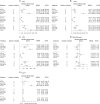Infiltrating T-cell markers in cervical carcinogenesis: a systematic review and meta-analysis
- PMID: 33257839
- PMCID: PMC7884592
- DOI: 10.1038/s41416-020-01184-x
Infiltrating T-cell markers in cervical carcinogenesis: a systematic review and meta-analysis
Abstract
Background: The host adaptive immune response helps determine which cervical HPV infections persist and progress to precancer and cancer, and systematic characterisation of T-cell infiltration would help inform key steps in cervical carcinogenesis.
Methods: A systematic review and meta-analysis were conducted of infiltrating T-cells in normal cervix, low-grade lesions, high-grade lesions, and invasive cancers including epithelial, stromal, and total tissue and the following markers: CD3, CD4, CD8, FoxP3, CD25, and the CD4:CD8 ratio. An additional qualitative review summarised longitudinal data on associations between infiltrating T-cells and cervical disease persistence, regression, progression, or prognosis.
Results: There were fewer CD3+, CD4+, and CD8+ cells in cervical lesions and more cells in cancers compared to normal epithelium. FoxP3 and CD25+ regulatory T-cell infiltration is high in persistent and precancerous lesions, and longitudinal data show improved outcomes with lower regulatory T-cell levels.
Conclusions: Successful immune evasion may reduce T-cell infiltration in HPV infected and precancerous epithelium, while invasive cancers are highly immunogenic, and regulatory T-cell infiltration increases with cervical disease progression. Understanding these factors may have prognostic value and could aid in novel treatment development and clinical guidelines, but published data are highly heterogeneous and leave important gaps to be filled by future studies.
Conflict of interest statement
Margaret Stanley has served as an ad hoc consultant for Innovio (2017) and Merck KgA Darmstadt (2019) and as a member of the Merck MSD global advisory Board. All other authors declare no potential competing interests.
Figures



Similar articles
-
Correlation of CXCL12 expression and FoxP3+ cell infiltration with human papillomavirus infection and clinicopathological progression of cervical cancer.Am J Pathol. 2009 Oct;175(4):1525-35. doi: 10.2353/ajpath.2009.090295. Am J Pathol. 2009. PMID: 19808652 Free PMC article.
-
Regulatory (FOXP3+) T cells as target for immune therapy of cervical intraepithelial neoplasia and cervical cancer.Cancer Sci. 2009 Jun;100(6):1112-7. doi: 10.1111/j.1349-7006.2009.01153.x. Cancer Sci. 2009. PMID: 19514119 Free PMC article.
-
Immunohistochemical analysis of CD4+ and CD8+ T-cell subsets in high risk human papillomavirus-associated pre-malignant and malignant lesions of the uterine cervix.Gynecol Oncol. 2006 Jul;102(1):22-31. doi: 10.1016/j.ygyno.2005.11.039. Epub 2006 Jan 20. Gynecol Oncol. 2006. PMID: 16427684
-
Immune concept of human papillomaviruses and related antigens in local cancer milieu of human cervical neoplasia.J Obstet Gynaecol Res. 2007 Apr;33(2):103-13. doi: 10.1111/j.1447-0756.2007.00492.x. J Obstet Gynaecol Res. 2007. PMID: 17441881 Review.
-
The prognostic value of tumour-infiltrating lymphocytes in pancreatic cancer: a systematic review and meta-analysis.Eur J Cancer. 2020 Jun;132:71-84. doi: 10.1016/j.ejca.2020.03.013. Epub 2020 Apr 22. Eur J Cancer. 2020. PMID: 32334338
Cited by
-
Risk factors for persistent infection of high-risk HPV in patients with cervical intraepithelial neoplasia.Am J Transl Res. 2025 Apr 15;17(4):2992-3000. doi: 10.62347/GGVR2248. eCollection 2025. Am J Transl Res. 2025. PMID: 40385069 Free PMC article.
-
FOXP3 Isoforms Expression in Cervical Cancer: Evidence about the Cancer-Related Properties of FOXP3Δ2Δ7 in Keratinocytes.Cancers (Basel). 2023 Jan 5;15(2):347. doi: 10.3390/cancers15020347. Cancers (Basel). 2023. PMID: 36672296 Free PMC article.
-
A Novel Immune-Related Signature to Predict Prognosis and Immune Infiltration of Cervical Cancer.Med Sci Monit. 2023 Mar 28;29:e938660. doi: 10.12659/MSM.938660. Med Sci Monit. 2023. PMID: 36973995 Free PMC article.
-
The Immune Response Generated against HPV Infection in Men and Its Implications in the Diagnosis of Cancer.Microorganisms. 2023 Jun 18;11(6):1609. doi: 10.3390/microorganisms11061609. Microorganisms. 2023. PMID: 37375112 Free PMC article. Review.
-
Chlamydia trachomatis enhances HPV persistence through immune modulation.BMC Infect Dis. 2024 Feb 20;24(1):229. doi: 10.1186/s12879-024-09094-6. BMC Infect Dis. 2024. PMID: 38378486 Free PMC article.
References
-
- Ferlay J, Soerjomataram I, Dikshit R, Eser S, Mathers C, Rebelo M, et al. Cancer incidence and mortality worldwide: sources, methods and major patterns in GLOBOCAN 2012. Int J. Cancer. 2015;136:E359–E386. - PubMed
-
- Bosch FX, Manos MM, Munoz N, Sherman M, Jansen AM, Peto J, et al. Prevalence of human papillomavirus in cervical cancer: a worldwide perspective. International biological study on cervical cancer (IBSCC) Study Group. J. Natl Cancer Inst. 1995;87:796–802. - PubMed
-
- Schiffman MH, Bauer HM, Hoover RN, Glass AG, Cadell DM, Rush BB, et al. Epidemiologic evidence showing that human papillomavirus infection causes most cervical intraepithelial neoplasia. J. Natl Cancer Inst. 1993;85:958–964. - PubMed
-
- Ho GY, Bierman R, Beardsley L, Chang CJ, Burk RD. Natural history of cervicovaginal papillomavirus infection in young women. N. Engl. J. Med. 1998;338:423–428. - PubMed

